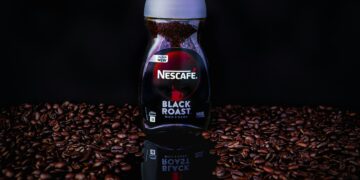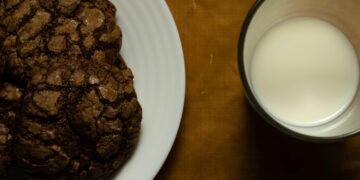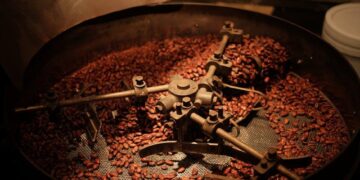Table of Contents
My name is Alex, and for the last 15 years, I’ve worked as a food scientist.
My world revolves around pH levels, microbial growth, and the complex chemistry of flavor.
I thought I had a handle on the basics.
That was until a gallon of my own homemade cold brew coffee decided to publicly humiliate me.
It was for a big family gathering.
I’d spent two days meticulously crafting what I believed was the perfect cold brew concentrate.
I used a coarse grind of beautiful, freshly roasted beans, steeped it in filtered water for a full 24 hours in the fridge, and double-strained it until it was crystal clear.
The first glass was sublime—smooth, chocolatey, with zero bitterness.
I was proud.
Three days later, I served it to my family.
The first sip was a shock.
The smooth, rich flavor was gone, replaced by a jarring, sour tang.
It was flat, lifeless, and faintly vinegary.
My perfect brew had betrayed me.
As a food scientist, the failure was particularly stinging.
I had followed all the common wisdom, the advice you read in every blog post and recipe.
Yet here I was, pouring my time-intensive creation down the drain.
That sour awakening sent me down a rabbit hole.
I realized the standard advice we all follow is dangerously incomplete.
It tells us what to do, but never truly explains why.
It treats cold brew like simple leftover coffee, a durable good that just needs to be kept cold.
This is the fundamental mistake.
This journey led me to an epiphany from a completely unexpected field, one that gave me a new paradigm for understanding cold brew.
It taught me to stop thinking like a cook and start thinking like a curator.
The Common Wisdom Trap: Why Standard Advice Lets You Down
The internet is full of well-meaning but inadequate advice for cold brew.
We’re told that concentrate can last for “up to two weeks” in the fridge.1
While not entirely false, this statement is like saying a car can go 500 miles without mentioning it needs gas, oil, and air in the tires.
It creates a false sense of security.
This gap between expectation and reality is a common source of frustration.
Homebrewers on forums share stories of their carefully made batches tasting stale or “like pennies” from oxidation after just five or six days.3
Others battle with brews that turn out bitter or sour, despite following the directions to the letter.4
These failures aren’t user error; they are the predictable result of an incomplete strategy.
The conventional wisdom fails because it ignores the two invisible enemies that are constantly working to destroy your coffee: rampant microbial growth and rapid chemical degradation.
Cold brew is not just a gentler, less acidic version of hot coffee; its very nature makes it uniquely vulnerable.
Its low-acid profile is a welcome mat for bacteria, and its delicate flavor compounds are incredibly fragile.
Simply putting it in the fridge is like parking a priceless convertible in a public garage with the top down—it might be safe from thieves, but it’s still exposed to dust, rain, and vandals.
The Art Restoration Epiphany: A New Paradigm for Preservation
My breakthrough came while reading about the conservation of Old Master paintings.
I was struck by the language art restorers use.
They don’t just “store” a Rembrandt; they create a meticulously controlled environment to actively fight against the forces of degradation—light, humidity, oxygen, and microbial attack.6
That was the “aha!” moment.
I had been treating my cold brew like leftovers.
I needed to treat it like a masterpiece.
This analogy—treating your cold brew like a priceless painting—is more than a clever metaphor; it’s a functional, scientifically-backed framework.
It reframes the problem from passive storage to active preservation.
A painting is an unstable chemical system, a delicate arrangement of pigments and oils constantly threatened by its environment.
So is your cold brew.
The moment you understand this, you can build a proper defense.
The Enemies of Art and Coffee: A Shared Battlefield
The same forces that conspire to fade a painting or crumble a sculpture are, in a chemical sense, the very same ones that turn your cold brew sour and stale.
- Environment (Temperature & Humidity): Museums are built around sophisticated climate-control systems that maintain a constant, cool temperature and stable humidity.6 This is their primary defense against the chemical and biological decay of the artwork. For cold brew, your refrigerator is your climate-controlled gallery—the single most important tool in slowing down its enemies.
- Light & Oxygen: Ultraviolet light is a notorious vandal, breaking down the chemical bonds in pigments and causing priceless paintings to fade.7 Oxygen is a more insidious enemy, slowly oxidizing materials and making them brittle and dull. For coffee, this is the exact process that destroys its aromatic volatile compounds, turning a vibrant brew into a flat, stale liquid.9
- Contaminants & Microbes: A conservator’s first step is often to meticulously clean away centuries of accumulated dust, soot, and grime.12 These aren’t just ugly; they can chemically damage the art and provide a food source for microbes. Even more dangerous is “biodeterioration,” where bacteria and fungi literally consume the artwork.13 This is a direct parallel to the two main contaminants in cold brew: microscopic coffee particles (“fines”) that cause bitterness, and the microbes (bacteria, yeast, mold) that make it sour and unsafe.3
- Structural Integrity: A painting relies on a stable support—a well-stretched canvas or a solid wood panel—to prevent cracking and flaking.6 The “structural integrity” of your cold brew is its purity. A brew contaminated with additives, impurities, or even excess water is inherently less stable and will degrade much faster.
Adopting the mindset of an art preservationist naturally equips you to build a multi-pronged defense strategy.
It shifts your goal from merely “keeping” your coffee to actively protecting a delicate, valuable creation from its known enemies.
The Preservationist’s Framework: A Scientific Defense
Understanding that you are fighting a two-front war is critical.
You are simultaneously battling microbial invaders for safety and chemical decay for flavor.
Most common advice only addresses one of these, which is why it so often fails.
A cold brew stored in an open jar in the fridge may be safe from most harmful bacteria, but it will oxidize and taste like cardboard in days.
Conversely, a brew sealed in an airtight container but left on the counter will be protected from oxygen but will quickly become a microbial hazard.
You must win both battles.
Defeating the Unseen Vandal: Microbial Spoilage
This is the battle for safety.
The smooth, low-acid taste of cold brew is its main appeal, but it’s also its greatest vulnerability.
The Science: The Low-Acid Danger Zone
Hot coffee brewing is essentially a pasteurization process; the high temperature kills most microbes.
Cold brewing, by definition, lacks this kill step.
Worse, the final product has a pH between 4.6 and 5.0, sometimes higher.14 In food science, any beverage with a pH above 4.6 is considered a “low-acid” food, placing it in a potential danger zone where harmful bacteria can thrive.18 Studies have shown that pathogens like
E.
coli and various spoilage yeasts and molds find cold brew to be a hospitable environment.14
Research from the University of Opole in Poland demonstrated that cold brew left at room temperature (15-25°C or 59-77°F) can exceed European safety limits for microbial activity in less than 24 hours.14
The Defense: The Climate-Controlled Gallery
Your defense against microbes is twofold, mirroring the practices of a museum conservator.
- Temperature Control: This is your primary weapon. Storing your cold brew at or below 5°C (41°F) is non-negotiable. This temperature is cold enough to dramatically slow the growth of most spoilage organisms.14 The “danger zone” for rapid bacterial growth is between 4°C and 60°C (40°F and 140°F).19 Your fridge is the only safe place for your brew.
- Sanitation: An art restorer wouldn’t work in a dirty studio; you cannot make clean coffee with dirty equipment. Every single item that touches your coffee—jars, pitchers, funnels, filters, spoons—must be thoroughly cleaned and sanitized before use. This prevents you from introducing microbial “vandals” at the very start. Experienced homebrewers often use a food-grade sanitizer like StarSan, a practice borrowed from beer making, to ensure their equipment is pristine.3
Halting the Invisible Fading: Chemical Degradation
This is the battle for flavor.
That intoxicating aroma of fresh coffee comes from hundreds of delicate, volatile organic compounds.20
These compounds are highly reactive and begin to break down the moment they are exposed to their greatest enemy: oxygen.
The Science: Flavor in Decay
Oxidation is the process that makes coffee taste stale, flat, papery, or metallic.1 Key aroma compounds, such as the wonderfully roasty-smelling 2-furfurylthiol, are rapidly degraded by oxygen.21 This process is accelerated by catalysts, primarily light and heat.10 Leaving your cold brew exposed to air and light is like leaving a painting in the sun—it will fade and degrade.
The Defense: The Archival Crate
To protect your coffee’s flavor, you must store it like a priceless artifact being shipped overseas.
- Airtight and Opaque Containers: Your storage vessel must block both oxygen and light. The best choices are airtight glass containers (like mason jars or flip-top bottles) that are made of dark or opaque glass, or containers made of stainless steel.4 Clear glass jars are a common mistake; they let in light that accelerates flavor decay.
- Minimize Headspace: The empty space at the top of your container is a reservoir of oxygen-rich air. The more air, the faster the oxidation. To combat this, fill your storage container as close to the top as possible to minimize this headspace. Using several smaller bottles instead of one large one is an excellent strategy, as you only expose a small portion of your batch to fresh air each time you open one.3
Maintaining Structural Integrity: Purity and Stability
The final piece of the preservation puzzle is ensuring the “structural integrity” of the liquid itself.
A pure, clean concentrate is inherently more stable than a contaminated or diluted one.
The Science: The Problem with Fines and Additives
After steeping, your brew contains microscopic, suspended coffee particles called “fines.” These are the enemy of longevity.
They continue to extract flavor over time, a process called “secondary extraction,” which leads to increasing bitterness and astringency.3 They also act as physical sites where spoilage reactions can begin, much like dust on a canvas can attract moisture and microbes.12 Furthermore, adding anything else—water, milk, sugar, creamers—dramatically destabilizes the brew.
These additives introduce sugars and proteins that are rocket fuel for microbes, and they dilute the coffee’s natural preservatives, slashing its shelf life to just a few days.4
The Defense: Meticulous Filtration and Purity
- Superior Filtration: To achieve a stable brew, you must remove as many fines as possible. This requires moving beyond basic cheesecloth. A multi-stage filtration process is best: first, a coarse metal strainer to remove the bulk of the grounds, followed by a fine filter like a paper V60 cone, a Chemex filter, or a dedicated nut milk bag to capture the fines.3 For the truly dedicated, home wine filtration systems can produce an incredibly clean and stable product.3
- Store It Pure: The preservationist’s golden rule is to store your cold brew as a pure, black concentrate. Only dilute and add extras to the portion you are about to drink, right before serving.
The following table summarizes the key threats to your cold brew and the preservationist techniques to defeat them.
| Enemy | Threat (The “Damage”) | Scientific Mechanism | Your Defense (The “Preservation Technique”) |
| Microbes | Sour, vinegary taste; mold growth; potential illness | Low acidity (pH > 4.6) allows bacteria, yeast, and mold to multiply, especially in the “danger zone” (4-60°C).14 | Refrigerate below 5°C (41°F) and maintain strict sanitation of all equipment.3 |
| Oxygen | Stale, flat, papery, or metallic taste; loss of aroma | Oxidation chemically alters and degrades volatile flavor and aroma compounds.10 | Store in airtight containers and minimize headspace by filling to the top or using smaller bottles.3 |
| Light | Accelerated flavor loss and staleness | UV light acts as a catalyst, speeding up the chemical reactions of oxidation.10 | Use opaque containers (dark glass, stainless steel) and store away from direct light.10 |
| Heat | Rapid microbial growth and accelerated flavor decay | Heat is a catalyst for both microbial growth and the chemical reactions of oxidation.10 | Brew and store in the refrigerator; never leave at room temperature for extended periods.14 |
| Impurities (Fines) | Increased bitterness and astringency over time | Microscopic coffee particles continue to extract soluble compounds (“secondary extraction”) after initial brewing.3 | Meticulous, multi-stage filtration using fine filters (paper, nut milk bags) to remove sediment.3 |
| Additives | Drastically shortened shelf life; rapid spoilage | Diluting with water weakens natural preservative effects. Milk and sugar provide nutrients for rapid microbial growth.4 | Store concentrate pure and black. Add water, milk, or sweeteners only to the glass immediately before serving.3 |
Your Cold Brew Preservation Toolkit: A Practical Guide
Adopting the preservationist’s mindset transforms cold brew from a gamble into a reliable craft.
The following table and protocol provide the practical tools you need to ensure every batch is a success.
Cold Brew Shelf Life At-a-Glance
This table provides a realistic guide to how long your cold brew will last when you follow the preservationist’s framework.
Note the critical difference between peak flavor and basic safety.
| Type of Cold Brew | Storage Condition | Expected Shelf Life (Peak Flavor) | Expected Shelf Life (Safe to Drink) | Key Considerations |
| Homemade Concentrate | Airtight, opaque container, refrigerated below 5°C (41°F) | 7-10 days | Up to 2 weeks | This is the most stable homemade form. Flavor degradation is the limiting factor.1 |
| Homemade Ready-to-Drink (diluted with water) | Airtight, opaque container, refrigerated below 5°C (41°F) | 2-3 days | 3-4 days | Dilution compromises stability. Make only what you’ll drink in the short term.1 |
| Homemade w/ Milk/Sugar | Airtight container, refrigerated below 5°C (41°F) | < 24 hours | 2 days, maximum | Additives are fuel for microbes. Spoilage is extremely rapid. Best consumed immediately.3 |
| Store-Bought (Opened) | Original container, refrigerated | 5-7 days | 7-10 days | Commercial products may be pasteurized or have preservatives, but are still vulnerable once opened.1 |
| Frozen Cold Brew Cubes | Freezer-safe bag/container | 1-2 months | Up to 3 months | Flavor quality degrades over time due to freezer burn and oxidation, but it remains safe.29 |
The Preservationist’s Protocol: A Step-by-Step Guide to Longevity
Follow this checklist to create a delicious and stable cold brew concentrate every time.
- Start with Quality Materials: Your final product can only be as good as your starting ingredients. Use high-quality, freshly roasted whole beans and clean, filtered water. The better the initial materials, the better the final flavor and stability.3
- Grind Coarsely: Immediately before brewing, grind your beans on a coarse setting, aiming for the texture of coarse cornmeal or raw sugar. A coarse grind minimizes the creation of fines and allows for a more even, controlled extraction.2
- Sanitize Everything: This step is non-negotiable for safety and longevity. Thoroughly wash and sanitize your brewing vessel, storage containers, funnel, and any stirring utensils.3
- Brew as a Concentrate: A concentrate is inherently more stable than a ready-to-drink brew. The lower water activity helps inhibit microbial growth, and the higher concentration of coffee’s natural antioxidants provides a better buffer against oxidation. A great starting ratio is 1:8 coffee-to-water by weight (e.g., 100 grams of coffee to 800 grams of water).27
- Steep Cold and Slow: For the most controlled extraction and best shelf life, steep your coffee in the refrigerator for 18 to 24 hours. This slow, cold process extracts the sweet, smooth compounds while minimizing the extraction of bitter acids and oils.27
- Filter Meticulously: Do not rush this step. Strain your brew twice. First, pour it through a simple metal strainer to remove the large grounds. Then, filter it a second time through a very fine filter—such as a paper coffee filter (like a V60), a nut milk bag, or multiple layers of cheesecloth—to remove the fine sediment.3
- Store Smart: Immediately transfer the finished, filtered concentrate into your clean, sanitized storage containers. Use airtight and opaque vessels (dark glass or stainless steel are ideal) and fill them as close to the top as possible to force out excess air.4
- Keep It Pure: Store the concentrate black and undiluted. Only add water, milk, ice, or sweeteners to the individual glass you are about to serve. This is the single most important step to maximize the lifespan of your batch.3
Reading the Signs: A Conservator’s Guide to Spoilage
Trust your senses.
An art conservator uses their eyes and experience to spot damage, and you can do the same with your cold brew.
It’s important to distinguish between spoilage that is merely unpleasant and spoilage that is potentially unsafe.
- Signs of Microbial Spoilage (UNSAFE): This indicates your brew has been compromised by bacteria, yeast, or mold. Discard it immediately.
- Smell: A sharp, sour, fermented, or vinegary odor.4
- Appearance: Any visible mold, which can look like white, green, or black fuzzy spots on the surface. Also look for unusual cloudiness that wasn’t there before, or a slimy texture.33
- The Rule: When in doubt, throw it out. No coffee is worth a foodborne illness.
- Signs of Chemical Spoilage (UNPLEASANT): This means your brew has oxidized. It is safe to drink but will not be enjoyable.
- Taste: The flavor will be flat, papery, and dull. It may have a metallic or “penny-like” taste.1
- Aroma: The original rich, sweet, chocolatey, or floral aromas will be gone, replaced by a generic “stale” smell.35
Conclusion: From Coffee Drinker to Coffee Preservationist
I think back to that disastrous family gathering, to the sour taste of my failed cold brew.
The frustration was real, but it forced me to look beyond the simplistic recipes and apply the principles of my own profession to my kitchen.
The shift was profound: I stopped being a passive coffee maker and became an active coffee preservationist.
Today, I make cold brew with confidence.
I know that the batch I brew on Sunday will taste just as smooth and delicious on Friday because I am no longer just storing it; I am actively defending it against its scientifically-defined enemies.
This is the power of the preservationist’s framework.
By understanding the why behind the process—the two-front war against microbes and oxidation—you are no longer at the mercy of a mysterious process.
You are in control.
You can eliminate the guesswork, reduce waste, and finally, reliably enjoy the fruits of your labor.
The perfect glass of cold brew isn’t just about the right beans or the right recipe; it’s about honoring the delicate creation you’ve made by giving it the protection it deserves.
Works cited
- How Long Can You Keep Cold Brew Coffee in the Refrigerator? Experts Explain, accessed August 3, 2025, https://www.marthastewart.com/8146833/how-long-cold-brew-lasts-refrigerator-storage-tips
- Mistakes to Avoid Cold Brew Coffee | The Kitchn, accessed August 3, 2025, https://www.thekitchn.com/cold-brew-mistakes-257657
- How do I make a batch of (cold brew) coffee last longer? – Reddit, accessed August 3, 2025, https://www.reddit.com/r/Coffee/comments/bbssfc/how_do_i_make_a_batch_of_cold_brew_coffee_last/
- Cold Brew Shelf Life: How Long It Lasts and How to Keep It Fresh …, accessed August 3, 2025, https://birchglenroasters.com/blogs/news/cold-brew-shelf-life-how-long-it-lasts-and-how-to-keep-it-fresh
- I can’t make cold brew as good as my office and it’s bothering me : r …, accessed August 3, 2025, https://www.reddit.com/r/Coffee/comments/mlemwa/i_cant_make_cold_brew_as_good_as_my_office_and/
- Art Conservation: Preserving the Past for the Future, accessed August 3, 2025, https://www.raullara.net/art-conservation-preserving-the-past-for-the-future/
- Art Restoration 101 – Can it be Restored? – Metropolitan Frame Company, accessed August 3, 2025, https://metropolitanframe.com/blog/art-restoration-101/
- The Fine Art Restoration Process – John Canning & Co., accessed August 3, 2025, https://johncanningco.com/blog/the-fine-art-restoration-process/
- How Long Can Cold Brew Coffee Sit Out Without Going Bad, accessed August 3, 2025, https://www.darkhorsecoffeecompany.com/blogs/coffee/how-long-cold-brew-coffee-sit-out
- The Shelf Life of Cold Brew: How Long Does It Last? – Dark Horse Coffee Company, accessed August 3, 2025, https://www.darkhorsecoffeecompany.com/blogs/the-three-gs-blog-grit-grind-and-gratitude/the-shelf-life-of-cold-brew-how-long-does-it-last
- How To Extend Coffee Shelve Life? 7 Tips For Fresher Brews – Vina Nha Trang, accessed August 3, 2025, https://vinanhatrang.com/how-to-extend-coffee-shelve-life/
- The Beauty of Science: New Technologies in Art Restoration, accessed August 3, 2025, https://illumin.usc.edu/the-beauty-of-science-new-technologies-in-art-restoration/
- Microbes as Enemies and Allies in the World of Art Conservation, accessed August 3, 2025, https://asm.org/articles/2021/december/microbes-as-enemies-and-allies-in-the-world-of-art
- How long can cold brew coffee last before it becomes dangerous …, accessed August 3, 2025, https://hardtank.com/2025/05/13/how-long-can-cold-brew-coffee-last/
- How roasters can prioritise food safety when making cold brew …, accessed August 3, 2025, https://perfectdailygrind.com/2025/05/how-to-prioritise-food-safety-making-cold-brew-coffee/
- Conservation and restoration of panel paintings – Wikipedia, accessed August 3, 2025, https://en.wikipedia.org/wiki/Conservation_and_restoration_of_panel_paintings
- Current Challenges of Cold Brew Coffee—Roasting, Extraction, Flavor Profile, Contamination, and Food Safety – MDPI, accessed August 3, 2025, https://www.mdpi.com/2078-1547/11/2/26
- Processing Shelf-Stable Beverages: Best Practices for Safety and …, accessed August 3, 2025, https://www.eurofinsus.com/food-testing/resources/processing-shelf-stable-beverages/
- How Long Does Cold Brew Last? – Colipse, accessed August 3, 2025, https://colipsecoffee.com/blogs/coffee/cold-brew-shelf-life
- The Chemistry of Aroma: Storage, Brewing, and Coffee Volatiles, accessed August 3, 2025, https://coffee-consulate.com/en/blog/The-Chemistry-of-Aroma
- Effect of Temperature and Storage on Coffee’s Volatile Compound Profile and Sensory Characteristics – PMC, accessed August 3, 2025, https://pmc.ncbi.nlm.nih.gov/articles/PMC11675256/
- Tweaking Coffee’s Flavor Chemistry, accessed August 3, 2025, https://library.sweetmarias.com/tweaking-coffees-flavor-chemistry/
- Degradation of the Coffee Flavor Compound Furfuryl Mercaptan in …, accessed August 3, 2025, https://pubs.acs.org/doi/10.1021/jf011329m
- Degradation of the coffee flavor compound furfuryl mercaptan in model Fenton-type reaction systems – PubMed, accessed August 3, 2025, https://pubmed.ncbi.nlm.nih.gov/11929297/
- Cold Brew Storage Tips – Buddha’s Cup, accessed August 3, 2025, https://buddhascup.com/blogs/kona-coffee-blog/cold-brew-storage-tips
- Bottling Cold Brew and semi long term storage? : r/Coffee – Reddit, accessed August 3, 2025, https://www.reddit.com/r/Coffee/comments/5dekqe/bottling_cold_brew_and_semi_long_term_storage/
- Cold Brewing (Home-Made) – Q&A – Barista Hustle Community Forum, accessed August 3, 2025, https://community.baristahustle.com/t/cold-brewing-home-made/1066
- The Shelf Life Of Cold Brew Coffee And 3 Ways To Extend It – Wake The Crew, accessed August 3, 2025, https://www.wakethecrewcoffee.com/blogs/news/the-shelf-life-of-cold-brew-coffee-and-3-ways-to-extend-it
- Does Cold Brew Coffee Go Bad & How To Make It Last?, accessed August 3, 2025, https://www.rimecoldbrew.com/does-cold-brew-coffee-go-bad-how-to-make-it-last/
- How Long Does Cold Brew Coffee Last? 3 Hacks To Extend Shelf Life – Watch Learn Eat, accessed August 3, 2025, https://watchlearneat.com/how-long-does-cold-brew-coffee-last/
- 10 Mistakes Everyone Makes With Homemade Cold Brew, According To An Expert Barista, accessed August 3, 2025, https://www.foodie.com/1528341/mistakes-steeping-cold-brew-list/
- how do you guys make cold brew? : r/Coffee – Reddit, accessed August 3, 2025, https://www.reddit.com/r/Coffee/comments/oi7rm7/how_do_you_guys_make_cold_brew/
- How long does cold brew last? – Breville, accessed August 3, 2025, https://www.breville.com/us/en/blog/coffee-and-espresso/how-long-does-cold-brew-last.html
- Does unopened cold brew go bad? How to make it last., accessed August 3, 2025, https://www.rimecoldbrew.com/does-unopened-cold-brew-go-bad/
- Changes in sensory quality characteristics of coffee during storage – PMC, accessed August 3, 2025, https://pmc.ncbi.nlm.nih.gov/articles/PMC3951592/






